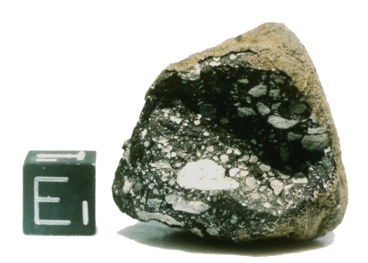Planetary Sample Analysis
The Moon is a witness to 4.5 billion years of solar system history, recording planetary differentiation, impact flux, and volatile evolution more completely and more clearly than any other planetary body. Asteroids are fascinating worlds ranging from small bodies containing a record of the earliest solar system processes to differentiated dwarf planets. Mars has a dynamic surface sculpted by almost every major geological process known - vast chasms, broad lava plains, ancient impact basins, and the largest volcano in the solar system.
The history of each planet is told through its rocks - how the minerals are put together, what the minerals are made of, and when the rocks were formed. We use multiple analysis techniques to understand the formation, modification, and age of planetary materials to learn about their parent planets.
The MSFC Planetary group maintains our own facilities for petrographic study and imaging with three state-of-the-art Olympus microscopes and two digital cameras (2 and 12 MPx). We collaborate with other groups for sample characterization with microbeam analyses, including Washington University in St. Louis (electron microprobe and SIMS), Oregon State University (electron microprobe), National Museum of Natural History (cathodoluminescence, TOF-SIMS), and NASA Johnson Space Flight Center (TEM, FIB).
The centerpiece of the MSFC facility is the MSFC Noble Gas Research Laboratory (MNGRL). Noble-gas isotopes are a well-established technique for providing detailed temperature-time histories of rocks and meteorites. In the MNGRL lab we use Ar-Ar and I-Xe radioactive dating to find the formation age of rocks and meteorites, and Ar/Kr/Ne cosmic-ray exposure ages to understand when the meteorites were launched from their parent planets.


Last Modified: March 8, 2016
Web Services provided by Bob Dean (MITS)
NASA Official: Barbara Cohen
Some of our current projects include the early impact history of the Moon through noble-gas dating of impact-melt rocks contained in lunar meteorites and Apollo breccia, the impact history of the asteroid belt by examination of meteorite breccias from large main-belt asteroids, age limits on terrestrial impact craters, and, and ages, exposure histories, and thermal history of new and unusual meteorites. We also support and participate in the collection of new planetary samples by participating in the Antarctic Search for Meteorites (ANSMET) and serving on the Meteorite Working Group (MWG) and Curation, Analysis, and Planning Team for Extraterrestrial Materials (CAPTEM).
ALH 81005, the first recognized lunar meteorite, which was recovered from the Antarctic. Scale cube is 1 cm.


